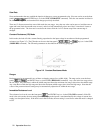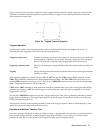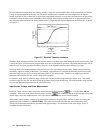
22 Operation Overview
Slew Rate
Slew rate determines the rate at which the input level changes to a new programmed value. Slew rate can be set at the front
panel (
, and ENTRY keys) or via the GPIB (CURR:SLEW command). This slew rate remains in effect for
the immediate, triggered, and transient level changes previously described.
There are 12 discrete current slew rates within each slew-rate range. Any slew rate value can be sent to a load (there are no
upper and lower limits that would cause an error), and a load will automatically select one of the 12 rates that is closest to
the programmed value. The slew rate is rescaled to the closest fit in the 1-of-12 discrete steps if the current range is
changed.
Constant Resistance (CR) Mode
In this mode, the load will sink a current linearly proportional to the input voltage in accordance with the programmed
resistance (see Figure 2-2). The CR mode can be set at the front panel (
,
and
keys) or via the GPIB
(MODE:RES command). The CR mode parameters are described in the following paragraphs.
Figure 2-2. Constant Resistance Mode
Ranges
Resistance may be programmed in any of three overlapping ranges (low, middle, high). The range can be set at the front
panel (
, , and ENTRY keys) or via the GPIB (RES:RANG command). Any value in the low range selects
the low range. Any value that is within the middle range and above the maximum low-range value selects the middle range.
Any value that is within the high range and above the maximum middle-range value selects the high range. Note that the
values of the present resistance settings may be automatically adjusted to fit within the new range.
Immediate Resistance Level
The resistance level can be set at the front panel (
and ENTRY keys) or via the GPIB (RES command). If the CR
mode is the active mode, the new setting immediately changes the input at a rate determined by the voltage or current slew
setting (see description below). If the load is not in the CR mode, the new setting is saved for use when the mode is changed
to CR.


















